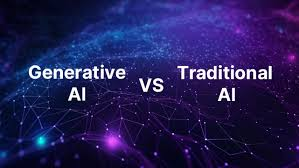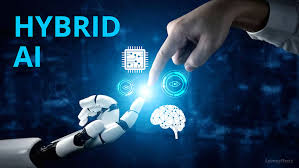As artificial intelligence (AI) continues to advance, it has revolutionized numerous industries and created new possibilities. Among its many subfields, Generative AI (Gen AI) has emerged as a fascinating development.

This blog will dive deep into the key differences between AI and Generative AI, explore their benefits, challenges, and applications, and help you determine which one suits your business needs.
What is Traditional Artificial Intelligence (AI)?
Traditional AI refers to systems that are programmed to mimic human intelligence by performing tasks such as decision-making, problem-solving, and pattern recognition. These systems rely on algorithms and data to learn and improve over time, enabling them to handle repetitive and complex tasks with precision.
Key Features of Traditional AI: A Comprehensive Overview
- Task-Oriented Functionality: Focused on performing specific tasks with efficiency and accuracy.
- Data-Driven Operations: Requires structured and unstructured data to train machine learning models effectively.
- Predictive Analytics Capabilities: Often utilized to predict future outcomes based on historical data patterns.
- Automation of Repetitive Tasks: Helps streamline workflows by automating mundane and time-consuming processes.
3 Top Benefits of Traditional AI Technology
- Significantly Improved Operational Efficiency: AI can process large volumes of data and perform complex calculations at speeds far beyond human capabilities, significantly enhancing operational efficiency across various industries.
- Reduction in Operational Costs: By automating repetitive and labor-intensive tasks, AI reduces the need for extensive manual labor, leading to significant cost savings for businesses in the long term.
- Enhanced Strategic Decision-Making: AI provides actionable data-driven insights, empowering businesses to make informed and strategic decisions that drive growth and innovation.
What Are the Real-World Applications of AI Across Industries?
- Healthcare Innovations: AI powers diagnostic tools, enables personalized medicine, and supports robotic surgeries, drastically improving patient outcomes and operational efficiency in the healthcare sector.
- Financial Services: It helps detect fraudulent transactions, analyze complex market trends, and provide personalized financial advice to clients.
- Retail and E-Commerce: AI enhances customer experiences through personalized recommendations, dynamic inventory management, and optimized pricing strategies.
- Manufacturing and Production: Predictive maintenance, quality control systems, and supply chain optimization are key areas where AI drives significant improvements in efficiency and output.
- Transportation and Logistics: AI underpins autonomous vehicles, route optimization, and traffic management systems, making transportation safer and more efficient.
What is Generative Artificial Intelligence (Generative AI)?
Generative AI is a specialized subfield of artificial intelligence that focuses on creating new content. Unlike traditional AI, which primarily analyzes and processes data, Generative AI uses neural networks and advanced algorithms to generate original outputs such as text, images, music, and even programming code.
Key Features of Generative AI: Breaking Down the Essentials
- Creative and Innovative Output: Capable of generating novel and unique content that aligns with specific user inputs or objectives.
- Advanced Deep Learning Models: Relies on sophisticated models like GANs (Generative Adversarial Networks) and transformer architectures, such as GPT and BERT.
- Human-Like Interaction and Creativity: Produces outputs that closely resemble human creativity and thought processes, making it highly versatile for creative industries.
3 Top Benefits of Generative AI for Modern Businesses
- Streamlined and Efficient Content Creation: Generative AI automates the creation of marketing materials, blog posts, video scripts, and other creative assets, enabling businesses to save time and resources.
- Accelerated Product Prototyping and Design: It can design virtual prototypes and models, significantly reducing the time and costs associated with traditional product development cycles.
- Enhanced User Experiences and Interactions: From AI-powered chatbots to virtual assistants, Generative AI powers tools that provide dynamic, engaging, and personalized user interactions across platforms.
What Are the Real-World Applications of Generative AI Across Different Sectors?
- Marketing and Digital Advertising: Generative AI creates compelling visuals, engaging videos, and optimized ad copy to enhance campaign effectiveness while reducing production costs.
- Entertainment and Media Production: Generative AI is used to create movie scripts, generate music, and design special effects for films and video games, pushing the boundaries of creativity.
- Education and Learning Solutions: AI develops personalized learning materials, interactive quizzes, and realistic simulations tailored to individual learning needs.
- Healthcare Research and Development: Generative AI generates synthetic medical data for research, aids in drug discovery, and supports the development of advanced diagnostic models.
- Customer Support and Experience Management: AI-powered chatbots and virtual assistants provide instant, accurate, and personalized responses, elevating customer support standards.
3 Top Challenges of AI and Generative AI in Real-World Implementation
- Concerns Over Data Privacy and Security: Both AI and Generative AI require vast amounts of data, raising concerns about how sensitive data is collected, stored, and utilized without breaching privacy regulations.
- Bias and Ethical Fairness Issues: AI models can inadvertently reinforce biases present in the training data, leading to unfair or unethical outcomes in decision-making processes.
- High Development and Implementation Costs: The development, training, and deployment of AI and Generative AI solutions can be prohibitively expensive, posing challenges for smaller businesses with limited budgets.
Difference Between AI and Generative AI: A Quick and Detailed Comparison
| Aspect | Traditional AI | Generative AI |
|---|---|---|
| Purpose | Analyzes and processes data | Creates new, original, and innovative content |
| Applications | Automation, analytics, decision-making | Content creation, design, and prototyping |
| Learning Models | Predictive and classification models | GANs, transformers, and deep learning systems |
| Output Type | Structured and task-oriented | Creative, unstructured, and dynamic |
AI vs. Generative AI: Which Technology Suits Your Business Needs?
Choosing between traditional AI and Generative AI depends on the specific needs and goals of your business:
- Traditional AI is ideal for organizations aiming to streamline operations, enhance predictive analytics, and automate repetitive workflows.
- Generative AI is better suited for industries requiring creative outputs, such as marketing, media production, and content generation.
Consulting with AI experts can help you assess your business requirements and implement the most suitable technology for achieving your objectives.
Conclusion
AI and Generative AI are transforming the way businesses operate, each offering unique advantages and addressing different challenges. While traditional AI focuses on data-driven tasks and operational efficiency, Generative AI opens new doors to creativity, innovation, and personalized experiences. By understanding their differences, benefits, and applications, you can harness the power of these technologies to meet your business objectives and stay ahead of the competition.
Overcome Your Business Challenges With Endevsol’s AI and Generative AI Services
At Endevsol, we specialize in delivering cutting-edge AI and Generative AI solutions tailored to your business needs. Whether you aim to optimize operations, create impactful content, or enhance customer experiences, our team of experts is here to help. Contact us today to unlock the transformative potential of AI and Generative AI for your organization.






